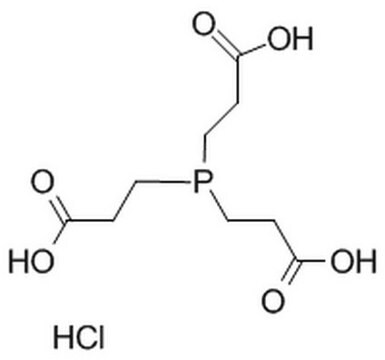52486
Tris(2-carboxyethyl)phosphine, immobilized on Agarose CL-4B
Synonyme(s) :
TCEP-Agarose, Tris(2-carboxyethyl)phosphine-Agarose
Se connecterpour consulter vos tarifs contractuels et ceux de votre entreprise/organisme
About This Item
Code UNSPSC :
12352204
Nomenclature NACRES :
NA.25
Produits recommandés
Niveau de qualité
Température de stockage
2-8°C
Application
Tris(2-carboxyethyl)phosphine, immobilized on agarose CL-4B may be used in preliminary off-line experiments to study its ability to cleave disulfide bonds by both under flow conditions using sequential injection analysis (SI). It may also be used as a reducing agent in bio-tests for disrupting the disulfide bonds within and between the proteins.
Actions biochimiques/physiologiques
Tris(2-carboxyethyl)phosphine also referred to as TCEP reduces the disulfides by the usual mechanism of reduction of disulfides by phosphines in water. Tris(2-carboxyethyl)phosphine, immobilized on Agarose CL-4B,Trialkylphosphines (TCEP) are highly effective agents for reducing disulfide bonds in proteins, peptides and other disulfide bondcontaining molecules and are relatively non-reactive toward other functional groups. The trialkylphosphine TCEP was first described by Levison et al. as an odorless and efficient reductant of alkyl disulfides over a wide pH range. TCEP is stable in aqueous solutions and does not undergo the rapid oxidation that often occurs with other reducing agents such as dithiotreitol (DTT) and β-mercaptoethanol (BME, 2-ME). TCEP does not interfere with commonly used sulfhydryl-reactive reagents (e.g., maleimide crosslinkers). Nevertheless, many protocols require recovery of the reduced sample separate from the reducing agent. Our Tris(2-carboxyethyl)phosphine, immobilized on Agarose CL-4B eliminates the need to use laborious and troublesome gel filtration methods to separate the reduced sample from the reducing agent. Immobilized TCEP Disulfide Reducing Gel may be adapted conveniently to a variety of scales and formats. Examples are given for batch, spin cup column and gravity-flow column procedures. For small-scale reductions, the most complete sample recovery is made using the spin-cup column procedure (see Related Thermo Scientific Products Section).
Remarque sur l'analyse
Bio-tests
Gel has an effective TCEP concentration ≥8 μmol/mL gel
Gel has an effective TCEP concentration ≥8 μmol/mL gel
Code de la classe de stockage
10 - Combustible liquids
Classe de danger pour l'eau (WGK)
WGK 3
Point d'éclair (°F)
Not applicable
Point d'éclair (°C)
Not applicable
Faites votre choix parmi les versions les plus récentes :
Déjà en possession de ce produit ?
Retrouvez la documentation relative aux produits que vous avez récemment achetés dans la Bibliothèque de documents.
Les clients ont également consulté
Preparation of Avidin Conjugates
Haugland, R.P. and Blalgat, M.K et al.
Methods in Molecular Biology, 189-190 (1998)
Burns, J.A.
The Journal of Organic Chemistry, 56, 2648-2648 (1991)
J C Han et al.
Analytical biochemistry, 220(1), 5-10 (1994-07-01)
The concentration of tris(2-carboxyethyl)phosphine (TCEP) can be conveniently determined by measuring the amount of 2-nitro-5-thiobenzoate (NTB) formed after reaction with 5,5'-dithiobis(2-nitrobenzoic acid) (DTNB). This method utilizes the fact that TCEP reduces DTNB rapidly and stoichiometrically to generate two equivalents of
Notre équipe de scientifiques dispose d'une expérience dans tous les secteurs de la recherche, notamment en sciences de la vie, science des matériaux, synthèse chimique, chromatographie, analyse et dans de nombreux autres domaines..
Contacter notre Service technique





